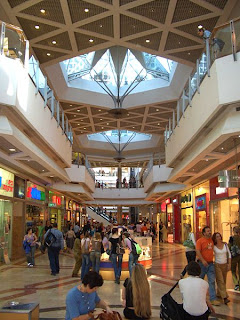ir a principal |
Ir a lateral
In many cases, regional and super-regional malls exist as parts of large superstructures which often also include office space, residential space, amusement parks and so forth. This trend can be seen in the construction and design of many modern supermalls such as Cevahir Mall in Turkey. The International Council of Shopping Centers' 1999 definitions were not restricted to shopping centers in any particular country, but later editions were made specific to the U.S. with a separate set for Europe. Regional malls
Regional malls The exterior of the Selfridges department store in the Bullring shopping complex in Birmingham, England.A regional mall is, per the International Council of Shopping Centers, in the United States, a shopping mall which is designed to service a larger area than a conventional shopping mall. As such, it is typically larger with 400,000 square feet (37,000 m2) to 800,000 square feet (74,000 m2) gross leasable area with at least two anchors and offers a wider selection of stores. Given their wider service area, these malls tend to have higher-end stores that need a larger area in order for their services to be profitable. Regional malls are also found as tourist attractions in vacation areas
The exterior of the Selfridges department store in the Bullring shopping complex in Birmingham, England.A regional mall is, per the International Council of Shopping Centers, in the United States, a shopping mall which is designed to service a larger area than a conventional shopping mall. As such, it is typically larger with 400,000 square feet (37,000 m2) to 800,000 square feet (74,000 m2) gross leasable area with at least two anchors and offers a wider selection of stores. Given their wider service area, these malls tend to have higher-end stores that need a larger area in order for their services to be profitable. Regional malls are also found as tourist attractions in vacation areas
Isfahan's Grand Bazaar, which is largely covered, dates from the 10th century A.D. The 10 kilometer long covered Tehran's Grand Bazaar also has a long history. The Grand Bazaar of Istanbul was built in 15th century and is still one of the largest covered markets in the world with more than 58 streets and 4000 shops.Gostiny Dvor in Saint Petersburg, which opened in 1785 and should probably be regarded as one of the first purposely-built shopping malls in the world, as it consisted of more than 100 shops covering an area of over 53,000 m².The Oxford Covered Market in Oxford, England was opened in 1774 and still runs today.The Burlington Arcade in London was opened in 1819. The Arcade in Providence, Rhode Island introduced the concept to the United States in 1828. The Galleria Vittorio Emanuele II in Milan, Italy followed in the 1860s and is closer to large modern malls in spaciousness. Other large cities created arcades and shopping centres in the late 19th century and early 20th century, including the Cleveland Arcade and Moscow's GUM in 1890. Early shopping centers designed for the automobile include Market Square, Lake Forest, Illinois (1916) and Country Club Plaza, Kansas City, Missouri (1924).An early indoor mall in the United States was the Lake View Store at Morgan Park, Duluth, Minnesota, which was built in 1915 and held its grand opening on July 20, 1916. The architect was Dean & Dean from Chicago and the building contractor was George H. Lounsberry from Duluth. The building is two-stories with a full basement and shops were originally located on all three levels. All of the stores were located within the interior of the mall with some shops being accessible from both inside and out.In the mid-20th century, with the rise of the suburb and automobile culture in the United States, a new style of shopping centre was created away from downtown.













